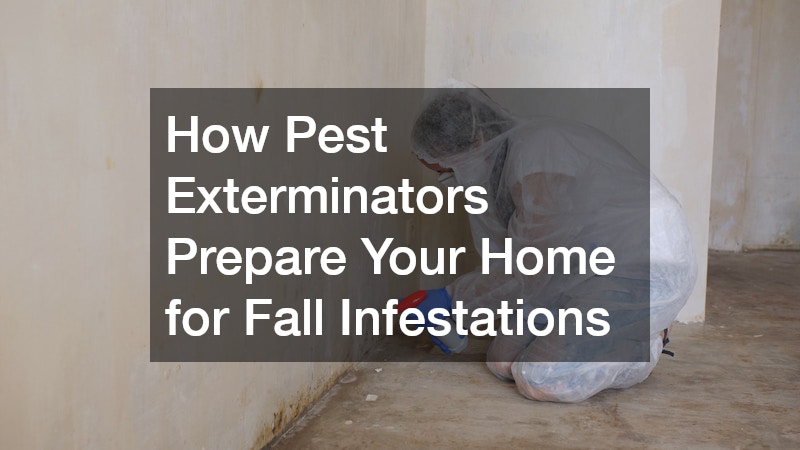As the seasons change and temperatures drop, many homeowners face the challenge of preventing pest infestations in the fall. Pest exterminators play a crucial role in preparing homes for this seasonal battle. This article delves into the key strategies and methods used by professionals to safeguard homes as autumn approaches.
Steps Exterminators Take to Prevent Fall Pests
Inspection and Identification
Before implementing any control measures, exterminators conduct thorough inspections to identify potential entry points and susceptible areas within a home. This involves examining the foundation, rooflines, windows, and doors for any cracks or openings. These inspections are pivotal in determining the most vulnerable areas that require immediate attention to prevent pests from entering.
Exterminators utilize various tools and techniques to ensure that no detail is overlooked during the inspection. They often use flashlights, ladders, and even drones for hard-to-reach areas to ensure they have a complete view of the home’s exterior and interior vulnerabilities. By meticulously identifying problem areas, exterminators can tailor their pest management strategies effectively.
Customized Treatment Plans
After identifying problem areas, a customized treatment plan is developed to effectively address the unique pest challenges of each home. Pest exterminators design tailored solutions that target the specific species identified during the initial inspection. These plans are essential because each home and pest situation is unique.
Factors such as the size of the property, severity of infestation, and the type of pests present are considered when developing a treatment plan. Exterminators may recommend a combination of chemical treatments, habitat alteration, and biological controls to address various pest problems simultaneously. This multifaceted approach ensures that every potential pest entry point and habitat is dealt with appropriately.
The Most Common Pests in the Fall
Rodents
Rodents, such as mice and rats, seek warmth and shelter in homes during fall, making them a common nuisance during this season. Their ability to squeeze through tiny openings makes them particularly challenging to keep out. Homeowners often first notice the signs of a rodent problem through droppings, gnawed materials, and strange noises in walls or attics.
Exterminators focus on identifying and sealing possible entry points that rodents use to access homes. They may also set traps in strategic locations to catch these pests and prevent future infestations. Constant vigilance and maintenance of home seals and barriers are crucial for keeping rodent populations at bay.
Besides physical measures, exterminators may suggest environmental changes to make the area less hospitable to rodents. This includes reducing clutter, which provides hiding places, and securing food sources that might attract these pests. By taking these proactive steps, homeowners can significantly reduce the likelihood of rodent problems during fall.
Insects
In addition to rodents, various insects seek refuge indoors, including spiders, cockroaches, and certain beetles. These pests are not only irritating but can also pose health risks by contaminating food or causing allergic reactions. Understanding the behavior and habitat preferences of these insects is crucial in crafting effective control strategies.
Exterminators often employ insecticidal treatments both inside and outside the home to target these unwelcome guests. Regular maintenance treatments may be prescribed to keep the insect populations in check throughout the fall season. Beyond chemical controls, they also advise on practices such as dehumidification and sanitation to minimize insect attraction.
Another effective strategy includes the use of physical barriers, such as screens and door sweeps, to prevent insects from entering. Exterminators stress the importance of keeping homes well-sealed and free of moisture accumulation, which can attract insects. By addressing these environmental factors, homeowners can create a less inviting environment for fall insects.
How Exterminators Seal Your Home Against Pests
Sealing Entry Points
Exterminators focus on sealing gaps, cracks, and holes that serve as entry points for pests. This includes both interior and exterior areas, ensuring a comprehensive approach to pest exclusion. Special attention is given to overlooked zones such as basements, attics, and garages, where pests often find their way in.
Materials such as caulk, expanding foam, and weather strips are commonly used to close these gaps and fortify the home against invaders. Professionals are skilled in identifying minor weaknesses in the home’s structure that homeowners may overlook. By meticulously sealing these entry points, exterminators significantly reduce the risk of pests breaching the home’s defenses.
Laying Down Barriers
Physical and chemical barriers may be used around the perimeter of the home to deter pests from entering. These barriers serve as an additional line of defense beyond sealing entry points. Physical barriers might include screens, trenching around the foundation, or installing metal flashing on vulnerable structures.
Chemical barriers typically involve treatments with pesticides designed to repel or kill pests upon contact. Exterminators carefully choose products based on the specific pests being targeted, ensuring minimal impact on the environment and non-target organisms. This targeted approach offers enhanced protection against a broad range of household pests.
Preparing your home for fall infestations requires a comprehensive approach, often best handled by professional pest exterminators. By understanding the strategies used and which pests to watch for, homeowners can take proactive steps to keep their homes pest-free as colder weather sets in. The expertise and vigilant work of exterminators ensure that as the seasons change, homes can remain safe and comfortable environments.

